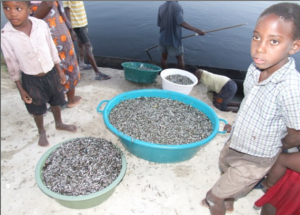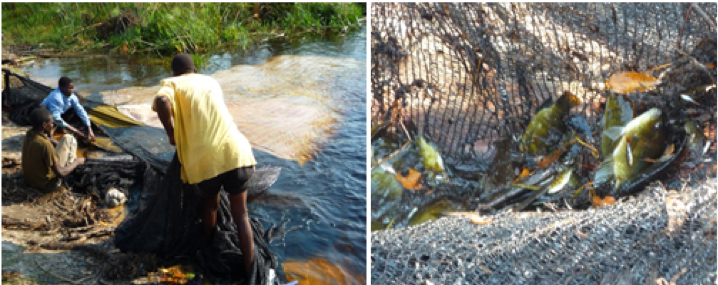First published on 09/25/2016, and last updated on 06/18/2025
By Denis Tweddle, Project Coordinator, NNF/EU Community Conservation Fisheries in KAZA Project, Katima Mulilo, Namibia
A recent ICCA Consortium newsletter article (A week in Zambia) described an ICCA field visit to the area of southern Zambia adjacent to the border with Namibia. The border is delineated by the Zambezi River which flows through an area of extensive floodplains covering over 2000 km2. One would expect such an area to support productive fisheries and contribute enormously to the food security of local rural populations.
This has indeed been the case from time immemorial through the first decade of this century. The river and the floodplain were in robust health and yielded an estimated 2-3,000 tonnes of fish annually. Regrettably, this is no longer true: in the past few years, the fishery has collapsed. The ICCA article identifies the switch from multifilament gillnets to nets made of monofilament, imported from China, as a major cause of this calamity.
The switch to monofilament nets has exacerbated the greatest problem affecting many African inland fisheries: the uncontrolled increase in fishing due to the rapid growth of the human population and the improved transport links between fishing areas and markets. Ironically, this situation was largely created by following the recommendations made by donor-driven fisheries development projects in the 1960s and ‘70s. In particular, the introduction of more effective fishing methods and improved access to markets contributed to the economic collapse of many African fisheries. Most of the fish caught in the Upper Zambezi no longer feeds local people but is exported to the Democratic Republic of the Congo.
A recent paper by Tweddle et al.. (2015, “Challenges in fisheries management in the Zambezi, one of the great rivers of Africa”. Fisheries Management and Ecology, 22: 99-111) highlights the economic collapse of fisheries throughout the Zambezi system, and the resulting increase in poverty in the predominantly rural areas around rivers and floodplains.
Human population growth results in more people fishing, which means each fisherman’s share of the catch from finite fish stocks is bound to decline. In a classic case of “the tragedy of the commons”, each fisherman increases his efforts to maintain his previous catch rate, and the fish stock declines even more. As these stepped-up efforts fail to produce the old level of fish catches, the next move is to introduce more effective fishing gears and methods, such as monofilament nets. In Zambia and Namibia, fishermen are also increasingly turning to environmentally damaging tools, such as long dragnets made of shade cloth, lined with cotton cloth so that nothing can escape. In Zambia, these are called sefa-sefa (sieves), a term that gives an apt description of what these nets do.
As for monofilament nets, our research and monitoring show that these nets are on average three times more effective than multifilament nets. Before 2010, the fishery on the Zambezi floodplains shared by Zambia and Namibia used static-set multifilament nets as a rule, but by 2012 these had been entirely replaced by monofilament. The use of nets that are three times more effective, combined with a series of high annual floods that should have greatly boosted fish populations might have been expected to significantly increase the levels of the communities’ catches.
Instead, by 2012, their catch rates declined to about a quarter of the 2010 level. Initially, the monofilament nets had large meshes, with the 5” (127 mm) openings allowed by the Zambian government. These had the unfortunate effect of targeting the breeding stocks of the large cichlid species (mainly tilapias). When these nets were actively fished as dragnets, the situation worsened.
Another destructive innovation was the use of drifting gillnets down the main river channel, rather than the previous method of setting them in a fixed position overnight. Fish are driven into the path of the net by beating the water and the riverbank where the fish shelter. As these large fish are effectively wiped out, increasingly smaller meshes are used, down to 1” (25 mm) in many cases, to catch the remaining smaller fish. Yet another problem with monofilament nets is that they are easily torn and therefore have a short life, but as they are also cheap they are simply discarded by fishers.
The river is full of abandoned nets that continue to “ghost-fish” for months, if not years, while nets abandoned on land trap and kill or wound terrestrial wildlife such as birds, lizards, snakes and small mammals. Even hippos have been seen entangled in such nets, and a hippo injured by the twine can become a very dangerous animal.

In the Upper Zambezi fishery, fishers using dugout canoes and large nets are male, hence the use of “fisherman” rather than the gender-neutral “fisher” in this article. Women and children also fish during the floods, but only on the floodplains using traditional basket traps and mosquito nets. They target the very small, highly prolific floodplain species, as shown in this photo, and do not impact on the larger species targeted by other gears. This is indeed a fishery that should be encouraged as a valuable contribution to food security. © D. Tweddle
What can be done to reverse this desperate situation? Government fisheries departments are handicapped by a severe lack of capacity (in terms of human resources, finances and infrastructure), and, unfortunately, there is an unrealistic expectation in many fishing communities that the government will be fully responsible for managing the fishery and controlling fishing methods.
The August 2015 ICCA Newsletter article highlighted this problem and also identified the only possible solution: control by the communities of their own members’ fishing practices. The article identified a potential obstacle to achieving this goal: a combination of “higher powers” that might prevent the communities from enforcing their own rules. This is complicated by the fact that the communities still expect government support and hesitate to take initiative themselves.
What’s more, the needed scientific recommendations about the best measures to use aren’t readily available to the communities or the authorities. There is a final challenge to be overcome: among these communities, there remains a lack of understanding that fisheries are not limitless and that the decline in catches is due to the fishers’ own activities and not to other factors such as climate change or divine intervention.
In the Upper Zambezi fishery, fishers using dugout canoes and large nets are male, hence the use of “fisherman” rather than the gender-neutral “fisher” in this article. Women and children also fish during the floods, but only on the floodplains using traditional basket traps and mosquito nets. They target the very small, highly prolific floodplain species, as shown in this photo, and do not impact on the larger species targeted by other gears. This is indeed a fishery that should be encouraged as a valuable contribution to food security. © D. Tweddle
As part of a long-term programme of the Namibia Nature Foundation in partnership with ministries and other organisations, a project entitled ‘Community Conservation Fisheries in KAZA’ is currently funded by the EU and has the aim of encouraging (and, hopefully, empowering) communities to take responsibility for managing their fisheries resources. Through this project, and supporting research programmes, the factors that have caused the Upper Zambezi fishery to collapse have been identified. The NNF/EU project is establishing community awareness programmes to share this information with fishing communities and to provide advice on the management measures that can be implemented by the communities themselves, ideally without the intervention of higher authorities.
One idea we emphatically do not support is the restocking of the river with fingerlings from fish farms. Introducing a few thousand tilapias reared at great cost in predator-free fish ponds to the Zambezi River simply feeds the tigerfish in the river for a few minutes and contributes nothing to the tilapia stock. Furthermore, the suggestion that this is an answer to overfishing sends the wrong message to the fishing communities. Instead, the protection of a viable breeding stock in the natural river system is the best and only real solution, and the NNF/EU project promotes community activities that will provide such protection.
Throughout the world, Marine Protected Areas (MPAs) are increasingly used to protect fish stocks, and in most cases their effectiveness has been demonstrated by improved catches by fishers in the adjacent, unprotected areas. This approach is increasingly understood by the Zambezi communities, and the concept of Fish Protection Areas (FPAs) is being adopted and, more importantly, understood by the communities.
Two pilot FPAs have been established by Namibian communities, one in Sikunga Conservancy and another in Impalila Conservancy. At the request of the conservancies, the FPAs have been formally designated as “Fish Reserves” by the Namibia Government, and the plans the conservancies formulated have been recognized as viable. Each of the protected river channels is about 12 km long, and together they represent a major commitment to protecting the breeding stocks. Trained guards are employed and paid by the conservancies to keep fishers out. In addition, the guards ensure that fishermen in the conservancies as a whole are obeying the government fishing regulations.
Among the fishing communities, the reaction to the FPAs has been generally positive, and other communities are now coming forward with proposals for their own FPAs. In Zambia, some communities have developed such plans and only await support for implementation of a network of protected breeding areas.
Employing guards to monitor the FPAs requires funding. This makes it difficult to implement where there is no formal community structure with sources of income, as is often the case with “conservancies”. The members of the exchange workshop on ICCAs that visited Zambia recently (see August 2015 newsletter) also visited Sikunga Conservancy in Namibia to learn about its FPA. In that meeting, Grazia Borrini-Feyerabend spotlighted a key issue to be addressed in promoting conservancy management of the fishery.
At present, fishing licences are issued by the government’s Regional Council and the communities get nothing in return. It is essential to find ways to include organised community structures (such as conservancies) in licensing. This will empower them, and this source of income will enable them to restrict fishing to sustainable levels and manage fisheries locally through cooperation with government fisheries departments
Once communities are empowered and develop the confidence to manage their fisheries, the role of central government fisheries organisations can be reduced. Instead of being resented as policing agencies, they can become allies of the communities, providing advice and support, and reacting to requests from communities for assistance in enforcing regulations only when problems arise that the communities cannot resolve themselves.
